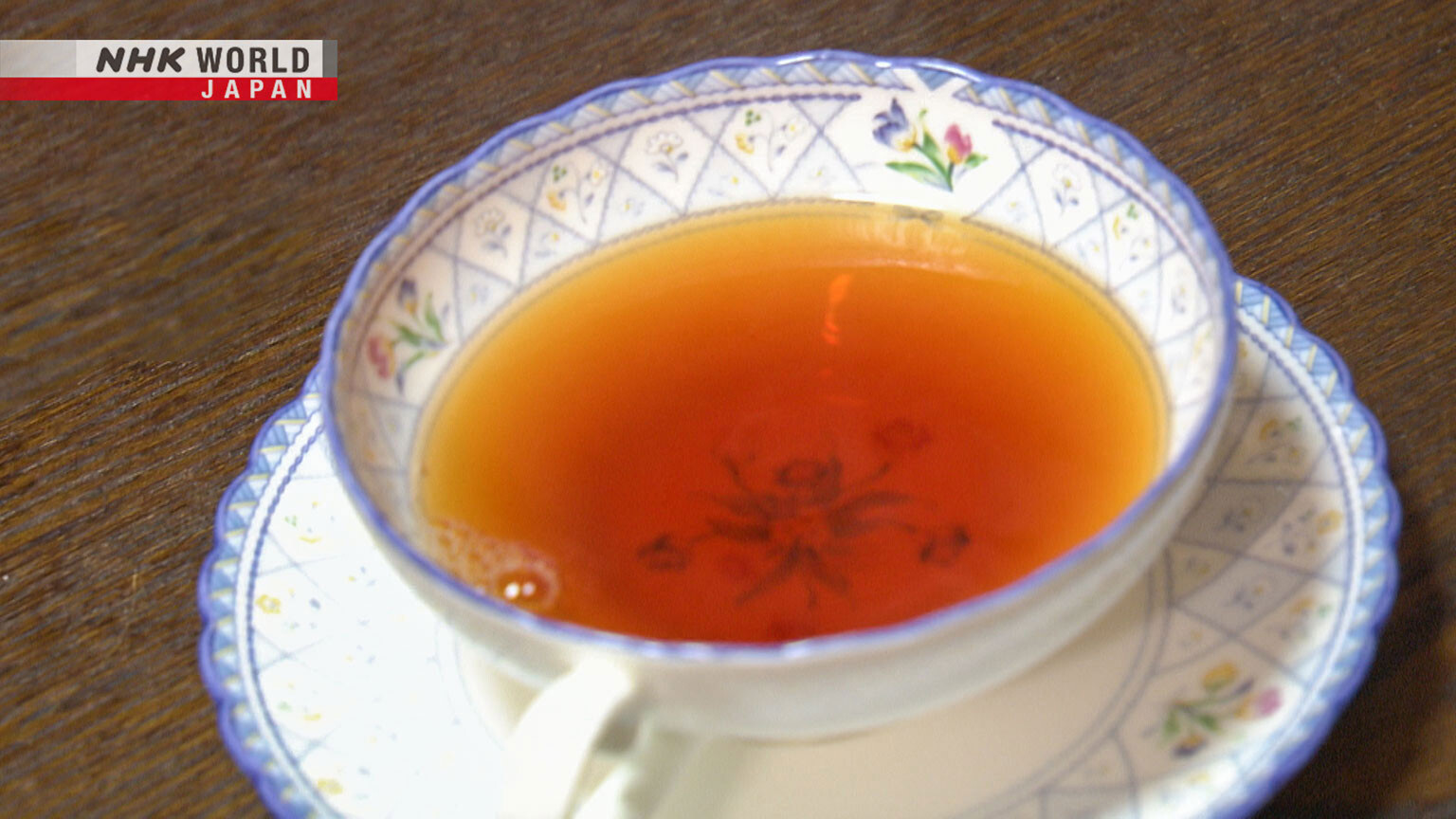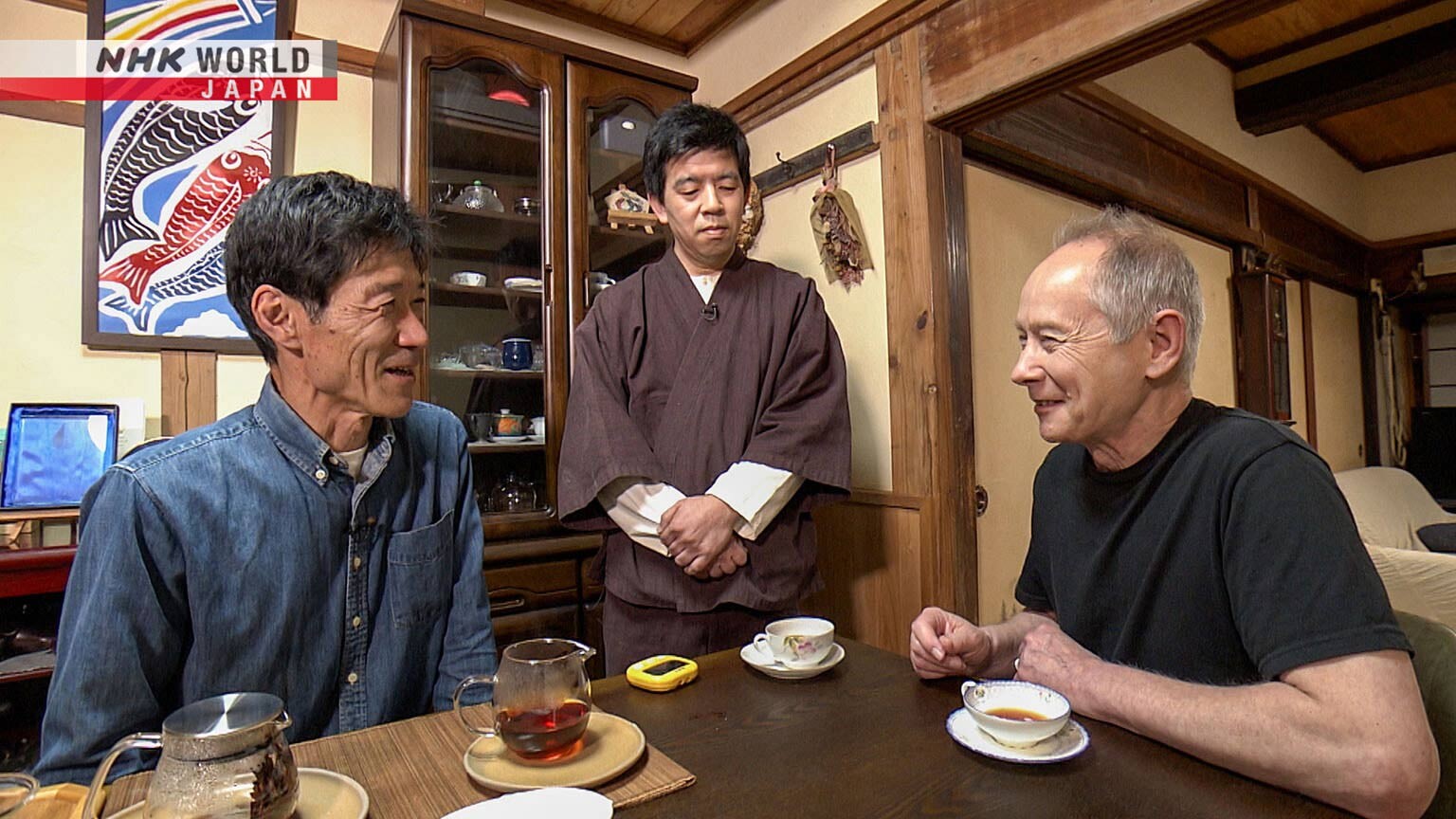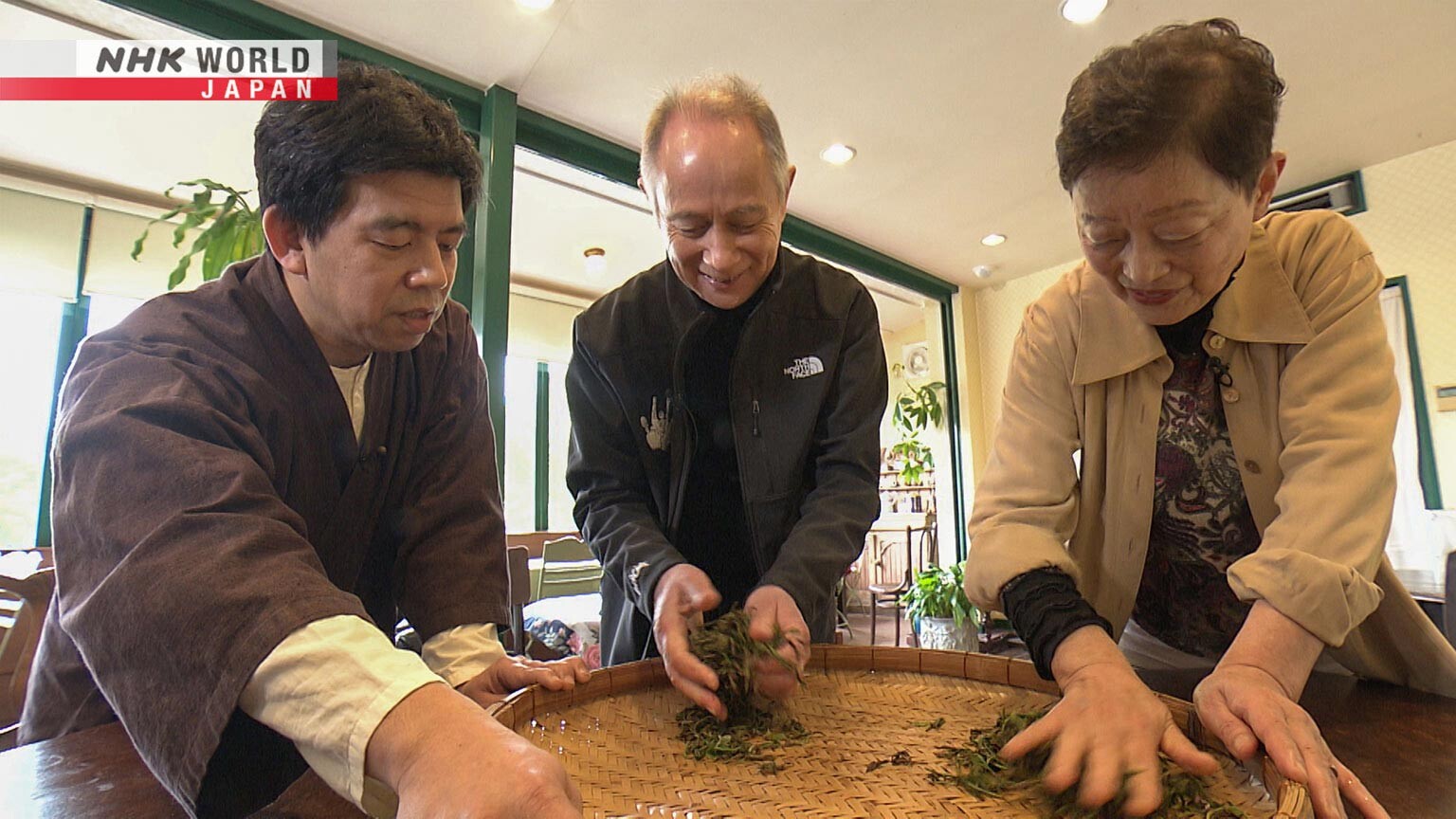Wakocha: Japanese Black Tea
*First broadcast on May 23, 2024.
Wakocha, black tea grown and processed in Japan, is winning major international awards. To discover why, Peter Barakan speaks to tea farmers, picks tea leaves, and tastes different varieties.



Transcript
Japanology Plus
Black tea that's been grown and
processed in Japan is called “wakocha.”
It's drawing the attention of
tea drinkers around the world.
To discover its secrets,
Peter Barakan heads to tea
farms in southwest Japan
to meet people who make this kind of tea.
It is. It's very tasty.
Hello, and welcome to Japanology Plus.
I'm Peter Barakan.
I'm standing in a tea field.
Now, when you say “tea” in Japan,
you're automatically going
to think of green tea,
whether it's the regular green tea
that everybody drinks every day,
or the strong powdered green tea
called matcha,
which is associated with the tea ceremony.
Either way, overwhelmingly
Japanese people drink green tea.
However, both green tea and black tea,
or what I call English tea,
both come from the same plant.
And in fact, these plants here are
going to be used for black tea,
which is called kocha in Japanese.
Now, black tea made in Japan,
called wakocha,
has recently been acquiring something
of an international reputation,
and in 2022, it won the top prize at
an international competition in London.
On today's program we'll see how
it's made, and what makes it so special.
Wakocha
Japanese Black Tea
Mr. Barakan!
- Hello.
- Nice to meet you.
I'm Okamoto Hiroshi.
This is our main guest.
Okamoto Hiroshi is one
of Japan's leading wakocha experts.
His shop in Saga Prefecture
specializes in Japanese black tea.
The teas he sells are carefully selected
and come from all over the country.
Okamoto teaches visitors how
to brew and enjoy each variety.
I've been drinking tea all of my life, and
in fact I still do drink tea every day,
but almost always it's teabags
that I buy in England.
I have drunk black tea that's made
in Japan, but not very often.
Perhaps you could explain
how it's different.
Well, “wakocha” does refer
to black tea that's made in Japan.
But that's not the whole story;
it has a complicated background
with many elements.
I think it's best you just drink
it and experience it yourself.
Ashikita in Kumamoto Prefecture.
On this small hillside farm,
tea is grown without the use
of pesticides or chemical fertilizers.
It's made by Kajihara Toshihiro.
A third-generation tea farmer,
he produces a world-class black tea.
The Leafies, a competition in London,
is organized by one of Britain's leading
authorities on tea,
the UK Tea Academy.
In 2022, Kajihara submitted
his Benifuki tea to this competition.
“Best in Show”
goes to Kajihara Tea Garden.
There were over 300 entries
from around the world,
and Kajihara took the top prize.
The taste of wakocha
made a strong impression
on the panel of 12 expert judges.
I think the wakocha had such
an impact for the judges particularly.
And it wasn't just a Japanese black tea.
That was completely...
almost like a completely new concept,
because they are just so unique.
And it's not really categorized
in any of other black tea
which was kind of standardized before.
Kajihara's Benifuki was completely
blown out all of the judges' mind.
So now let's visit Kajihara's home, where
Peter will try the award-winning tea.
Oh, you've got all kinds
of diplomas and things.
They're actually certificates
from various competitions.
Here's the trophy I won in 2022
at The Leafies in London.
Congratulations. Wow.
I can't wait to try it.
Let's brew some Benifuki,
the variety that won “Best in Show.”
OK you decant it.
Oh, it looks...it's a very nice color.
A deep red.
OK.
Thank you.
It is. It's very tasty.
There's a slight bitterness to it,
but only very little.
There's a kind of depth to it too.
Normally I drink my tea with milk,
but this is probably better as it is,
I would imagine.
Yes, it's best to drink it straight.
Definitely a better class of tea.
For comparison, Peter will try a teabag
from a major British company.
There's a slightly harsher taste,
I suppose.
This would probably be better with milk.
How's the aroma?
This is kind of a bitterer feeling.
How about the Benifuki?
This one has more aroma, really.
I'm so used to drinking this kind
of tea that it feels quite, quite natural.
But when you compare the two,
this is definitely a superior tea.
You can tell.
People might say, “So that kind
of field produces this kind of taste,”
This is what Benifuki is like,
or “This is the Kajihara flavor.”
That really is almost like wine, isn't it?
That's a common comparison.
So you hear words like “terroir,”
for example.
OK.
So this grower has,
let's see...four different fields,
so each different field is going
to have a different taste.
Strictly speaking, yes.
Other factors include the climate,
and exactly when you picked the leaves.
We can only produce a small
amount of each variety,
but we have loyal customers
who look forward to
and wait patiently for our teas.
What kind of different types do you have?
Well, shall we brew some
more tea for you to try?
OK, yeah. Absolutely.
Peter will try three
of Kajihara's most popular varieties.
First, “Zairai,” a native tea that
has grown wild here for centuries.
Here goes with the Zairai.
That's quite a mild taste. But flavorful.
And that's been around for a long time?
So this would have been
used to make green tea?
It actually still is.
This is our most popular tea.
It's easy to drink and has a great aroma.
Next, try this one.
It's called Koshun.
This is very easy to drink as well.
It's a bit different.
I'm trying to think how.
A touch more bitterness to this, perhaps.
Both Koshun and Zairai were
originally used to make green tea.
So they're not too astringent or bitter.
But the Zairai is more delicate.
Oh, that's true.
Lastly, we go back to
the award-winning tea, Benifuki.
OK. I'll just try this one again.
This does have more punch to it,
doesn't it?
And yours was chosen as number
one out of 300 different ones?
That's right.
That really is impressive.
Thank you very much.
It is both refined and pungent.
It strikes a wonderful balance,
which is why it was rated so highly.
If pungency were the only criterion,
other teas would surpass it.
Yeah, it's...obviously it's got to
be a good balance, hasn't it?
So Kajihara-san, how long have
you been making this kind of tea?
Did you start off with green tea?
I did.
I began producing black tea
as well around thirteen years ago.
Was there a special reason
why you switched?
Green tea sales were dwindling.
Really?
This is the country
of green tea, isn't it?
Nevertheless, consumption has declined.
Lots of other drinks have appeared
on the market and become popular.
So it must have been a bit of
a gamble though, to switch to black tea.
And how successful has the black tea been?
Thankfully, demand is higher than supply.
Mass production isn't possible.
It's grown on a rocky slope,
in rough terrain.
But I believe
that makes it easier to showcase the
individual characteristics of each tea.
I'm not aiming for particular flavors.
I'm more interested in seeing
what emerges naturally.
Most varieties of tea come from
the same tea plant: Camellia sinensis.
It originated in southwest China,
then spread throughout the world.
Different cultures developed
their own takes on tea.
In Japan, green tea is especially popular.
To make it, freshly picked
tea leaves are heated.
This prevents oxidation.
For black tea, meanwhile,
the leaves must be allowed to oxidize.
Black tea is enjoyed throughout Asia.
In Turkey, it's brewed to be full-bodied,
and served with lots of sugar.
Indian chai is brewed
with milk and spices.
Malaysians enjoy “teh tarik,”
which features condensed milk.
The resulting drink is frothy and sweet.
Green tea arrived in Europe
during the 17th century.
But it was black tea that
became the preferred choice.
It was particularly popular
among the British aristocracy.
And in due course tea drinking
spread to the general public.
People began to enjoy “afternoon tea,”
which also features sandwiches and scones.
In the UK, people commonly add
milk and sugar to their black tea.
Next stop: Minamikyushu,
known for its green tea.
Oh my...
I was not expecting to see one of those.
A London bus.
The number 27 to Richmond. Well.
The question is, what is a London bus
doing in the southern part of Kyushu?
To answer that question,
let me introduce you to the proprietor.
Here she is, Tanaka-san.
Nice to meet you.
Hello, and thank you for coming.
This is Tanaka Kyoko.
She moved here from Osaka in 1967,
after getting married.
Tanaka is a certified tea instructor
and an aficionado of British culture.
She opened this combined
museum and tea room
as a place to share her
enjoyment of black tea.
It draws many visitors.
In the year 2000 she
acquired her own field,
and despite a lack of experience,
began growing tea.
The resulting products drew international
acclaim and won major awards.
Tanaka-san is a true Anglophile,
and she even established a museum.
Would you show us around?
Of course.
The bus is part of Tanaka's collection.
Let's see what's in the building.
Here are the exhibits.
This is the Anglo-Satsuma Museum.
It documents over 160 years
of interactions
involving the UK and this region
in southwest Japan—
formerly known as Satsuma.
There's a special focus on tea,
and a number of significant
items are displayed.
This is about the origin of
black tea production in Japan.
It was the 19th century,
and in those days,
tea was exclusively for export.
That's what is shown here.
Back then, most Japanese people
hadn't even heard of black tea.
They would have asked,
“How is that different from green tea?”
But Japan was just starting to build
relationships with other countries.
It was searching for ways to generate
an income through international trade.
Japan started making black tea
as a commodity
that could be exported and sold.
Production really took off.
Ah, OK.
So it was a diplomatic tool?
Yes. But that didn't last forever.
Trade liberalization in 1971
changed everything.
Black tea was no longer a money maker,
so for economic reasons,
the tea industry decided to shift
its focus to green tea production.
Until that point, black tea
was produced for export.
It was grown in large fields, and sold
to other countries around the world.
It was intended to appeal to foreign
consumers and was mass-produced.
But trade liberalization
brought that to an end.
So farmers started making a product
that suited the Japanese market.
And that trend has continued
to the present day.
The exhibition is not the only attraction.
Visitors can also get
a first-hand experience of picking
and processing black tea.
Peter's going to give it a go.
This is my tea field.
Very nice.
I've never picked tea before, so you're
going to have to tell me how it's done.
It's fun!
There's a bud here.
Uh huh.
One bud with one, two, three leaves.
That's about right. You just pull it off.
Alright.
So...here?
Yes.
OK, good.
Alright.
Tanaka grows tea without using
any pesticides or chemical fertilizers.
I'm going to go here actually.
That's...there we go.
Don't use too much force.
Crushing it will spoil the flavor.
In general,
we want one bud and three leaves.
But the situation changes
somewhat every day.
Picking by hand allows you to fine-tune.
It's a form of craftsmanship.
That's the advantage of hand-picking.
The leaves are left to dry for
half a day or a day, then rolled.
The way they are rolled greatly
affects the final taste.
We're going to demonstrate how
rolling technique affects flavor.
So go ahead—but be gentle.
OK.
Tanaka, meanwhile, is being more forceful.
Like this?
Very good. I can tell the tea is happy.
For a more pungent taste,
you apply more pressure.
For a delicate taste,
you roll the leaves much more gently.
It's not like bread,
which reacts to yeast.
We oxidize the leaves.
In order to do that,
we need to damage them a little bit.
It's like a cut apple turning brown.
Ah OK, it's as simple as that.
The rolled leaves are placed in a warm,
humid environment,
and left to oxidize for around an hour.
This is different from green tea,
which is not oxidized at all.
At the right moment,
the leaves are heated.
This halts the oxidation process.
The final step is to dry
them for half an hour.
OK, they should be about ready.
First, these leaves.
Oh, that's looking quite different now,
isn't it? Yeah.
Now these bigger leaves.
That's really starting to
look like tea now, isn't it?
This one was gently rolled.
You can still see the shape of the buds.
This was firmly rolled.
The leaves are entwined.
In English,
you refer to this as “black tea.”
It is said that the name comes from
this dark color that the leaves
take on once they've been dried.
That's one theory, at least.
Could be.
Right, I'd never thought about that. Yeah.
Because unless you
compare it with green tea,
you just take it for
granted that it's tea.
Wakocha is difficult to mass produce,
but a new business is helping
farmers to increase their sales.
It was created by Negishi Jiro,
a tea instructor.
He travels throughout the country,
promoting wakocha and
teaching about its history.
In 2021,
Negishi established a wakocha delivery
service and sought out subscribers.
Kubo Masayuki is his business partner.
They carefully select teas
from across the country.
Wonderful. They're all good.
Once every two months,
they send each subscriber packs of rare,
high-quality black tea.
The delivery includes printed information
about each tea farm and farmer.
It also explains the best way
to brew the different varieties.
It's not easy to meet
farmers face-to-face,
so we try to inform subscribers
about new developments,
available varieties, and so on.
Each farmer has their own story,
varieties of tea, and production methods.
We think that sharing this
with our customers
tends to encourage them to try new teas.
That's my main goal.
Hello!
Homma Asami is a subscriber
for this wakocha delivery service.
Interesting.
Smells good.
A pretty orange color.
It's beautiful.
I love tea,
so I do search for different varieties.
But it can be very difficult
to find what I'm looking for.
This service gives me more
chances to discover new teas.
It's wonderful.
I've boiled some water,
so let's get brewing.
OK, let's try them out.
The firmly rolled tea is turning
a deep reddish color.
Whereas the gently rolled tea...
Pale yellow color, yeah.
It is pale, yes.
That's the firmly rolled tea.
And here's the gently rolled tea.
It's much lighter.
Ah, it's a very pale color, yeah.
But they're both identical
leaves from the same plant.
Yes, how you roll it makes
this much difference.
OK. This one first?
That's a very light taste, yeah.
That's...
although it's black tea,
the taste is a little bit
close to green tea.
It has a freshness to it.
And this one too, actually.
It's a slightly more robust flavor to it.
But it's still...
you can tell it's Japanese tea.
Interesting.
I guess what I liked was
the idea that it's very local.
These days everything...you hear
nothing but globalization all the time.
And the idea that something
can be extremely local
just kind of appeals to me.
Especially, I mean,
you're growing it organically.
You don't use any chemical
fertilizers or anything.
And it's just a very small amount.
You're not doing it to make millions.
And that just seems a pleasant
alternative. To me, anyway.
Satsuma nouveau!